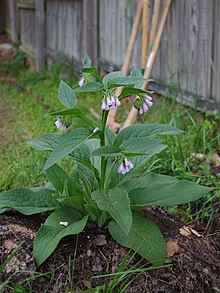심피툼
Symphytum| 심피툼 | |
|---|---|
 | |
| 백인종 | |
| 과학적 분류 | |
| 왕국: | 플랜태 |
| Clade: | 기관지 식물 |
| Clade: | 혈관배양액 |
| Clade: | 유디코트 |
| Clade: | 별자리 |
| 주문: | 보라기날레스 |
| 패밀리: | 보라긴과 |
| 서브패밀리: | 보라기노이데아과 |
| 속: | 심피툼 l. |
| 모식종 | |
| 오피시날레 l. | |
| 종. | |
| 텍스트를 참조해 주세요. | |
Symphytum은 보라지과에 속하는 현화식물속이다.comfrey(/kmmfri/로 발음)라는 통칭으로 알려진 최대 35종이 [1]있다.일부 종과 잡종, 특히 S. officinale, Symphytum grandiflorum, S. × uplandicum은 정원 가꾸기와 한약재로 사용된다.그들은 야생 컴프리로 알려진 안데르송로섬 버진리아눔과 [2]혼동해서는 안 된다.
종.
종류는 다음과 같습니다.
- 아스페룸(Symphytum asperum) – 따끔따끔한 컴프리, 거친 컴프리
- 구근균 – 구근균
- 시피툼브라키칼릭스 - 팔레스타인산 콩프리
- 백인종 – 백인종
- 포복성 콩프리
- 시피툼 이베리쿰 – 이베리아 컴프리[3]
- Symphytum 오피시날레 – comfrey
- 심피툼 오리엔탈– 화이트 컴프리
- 시피툼 타우리쿰 – 크림 컴프리
- 덩이줄기 - 덩이줄기콩프리
- Symphytum × uplandicum (S. asperum × S. officinale, 동의어: S. peregrinum) – 러시아산 컴프리, 힐링 허브, 블랙워트, 멍울트, 월워트, 잇몸 식물
재배
러시아산 컴프리 '보킹 14' 품종은 1950년대 에식스주 [4]보킹에서 시행된 실험 이후 헨리 더블데이 연구 협회(Henry Doubleday의 이름을 딴 유기농 원예 단체)의 설립자인 로렌스 D 힐스에 의해 개발되었다.
전파
보킹 14는 무균이기 때문에 씨앗이 정착되지 않는다(다른 품종보다 잘 퍼지지 않기 때문에 그 장점 중 하나)는 뿌리 절단에서 번식한다.정원사는 흙 표면 아래 약 7cm (2.8인치)의 잎 덩어리를 가로로 뚫고 삽을 박음으로써 성숙하고 강하게 자라는 식물로부터 "사발"을 생산할 수 있다.이렇게 하면 크라운이 제거되고 크라운은 여러 조각으로 분할됩니다.원래의 식물은 빠르게 회복되어 각각의 조각을 토양 표면 바로 아래에 있는 생장점으로 옮겨 심을 수 있으며, 빠르게 새로운 식물로 자랄 것입니다.오프셋은 전문 탁아소에서 통신 판매로 구입하여 초기에 식물 [5]재고를 쌓을 수도 있습니다.
식물화학, 민간약 및 독성
컴프리의 민속 의학 이름은 니트본, 뼈 세트, 그리고 고대 용도를 가리키는 라틴어 이름 Symphytum의 유래를 포함합니다.마찬가지로, 일반적인 프랑스어 이름은 consoude로, 함께 용접한다는 의미입니다.다른 문화와 언어들의 전통은 뼈를 치료하는데 유용하다는 공통의 믿음을 암시한다.
컴프리는 알란토인,[6] 점실라지, 사포닌, 타닌, 피롤리지딘 알칼로이드 및 이눌린을 포함한 다양한 양의 혼합 피토케미칼을 함유하고 있다.피롤리지딘 알칼로이드는 간독성 [7]생성의 원인이다.간 독성은 이 식물이나 그 [6]추출물을 섭취하는 것과 관련이 있다.현대 약초학에서는 컴프리가 가장 일반적으로 [6][8][9]국소적으로 사용된다.
2001년 미국 식품의약국은 내부용으로 판매되는 컴프리 제품의 금지와 외부용으로 [10][11]판매되는 제품에 대한 경고 라벨을 발행했다.Comfrey는 임신과 수유 중, 유아 및 간,[6][12] 신장 또는 혈관 질환이 있는 사람에게 특히 금기된다.
레퍼런스
- ^ Miranda, Kimberley (9 July 2010). "Symphytum". hortweek.com. Retrieved 23 April 2017.
- ^ USDA, NRCS (n.d.). "Cynoglossum virginianum". The PLANTS Database (plants.usda.gov). Greensboro, North Carolina: National Plant Data Team. Retrieved 2018-11-20.
- ^ "Symphytum ibericum". rhs.org.uk. Retrieved 23 April 2017.
- ^ Alfrey, Paul (3 June 2016). "Comfrey – BELIEVE the HYPE!". Permaculture Research Institute. Retrieved 1 June 2021.
- ^ Teynor, Putnam, Doll, Kelling, Oelke, Undersander, and Oplinger. "Comfrey". Alternative Field Crops Manual. University of Wisconsin, Extension, Cooperative-Extension. Retrieved 25 March 2014.
{{cite web}}: CS1 maint: 여러 이름: 작성자 목록(링크) - ^ a b c d "Comfrey". Drugs.com. 17 July 2017. Retrieved 22 May 2018.
- ^ Mei, Nan; Guo, Lei; Fu, Peter P.; Fuscoe, James C.; Luan, Yang; Chen, Tao (October 2010). "Metabolism, genotoxicity, and carcinogenicity of Comfrey". Journal of Toxicology and Environmental Health Part B: Critical Reviews. 13 (7–8): 509–526. doi:10.1080/10937404.2010.509013. PMC 5894094. PMID 21170807.
- ^ Grant, G; Nolan, M; Ellis, N (July 1990). "A reappraisal of the Malaise Inventory". Social Psychiatry and Psychiatric Epidemiology. 25 (4): 170–8. doi:10.1007/BF00782957. PMC 2399473. PMID 2399473.
- ^ Miller, Lucinda G. (9 November 1998). "Herbal Medicinals: Selected Clinical Considerations Focusing on Known or Potential Drug-Herb Interactions". Archives of Internal Medicine. 158 (20): 2200–2211. doi:10.1001/archinte.158.20.2200. PMID 9818800.
- ^ "FDA/CFSAN – FDA Advises Dietary Supplement Manufacturers to Remove Comfrey Products From the Market". Food and Drug Administration. Retrieved 2007-06-01.
- ^ Koll, R; Klingenburg, S (2002). "Therapeutische Eigenschaften und Verträglichkeit topischer Beinwellzubereitungen bei Prellungen, Zerrungen, Verstauchungen sowie bei schmerzhaften Muskel- und Gelenkbeschwerden: Ergebnisse einer Beobachtungsstudie an Patienten" [Therapeutic characteristance and tolerance of topical comfrey preparations. Results of an observational study of patients]. Fortschritte der Medizin (in German). 120 (1): 1–9. PMID 14518351.
- ^ Yeong, Mee Ling; Swinburn, Boyd; Kennedy, Mark; Nicholson, Gordon (March 1990). "Hepatic veno-occlusive disease associated with comfrey ingestion". Journal of Gastroenterology and Hepatology. 5 (2): 211–214. doi:10.1111/j.1440-1746.1990.tb01827.x. PMID 2103401. S2CID 42511497.
외부 링크
- Giannetti, B. M.; Staiger, C.; Bulitta, M.; Predel, H.-G. (1 July 2010). "Efficacy and safety of comfrey root extract ointment in the treatment of acute upper or lower back pain: results of a double-blind, randomised, placebo controlled, multicentre trial". British Journal of Sports Medicine. 44 (9): 637–641. CiteSeerX 10.1.1.1030.3598. doi:10.1136/bjsm.2009.058677. PMID 19460762. S2CID 5432523.
- 헬스라인




